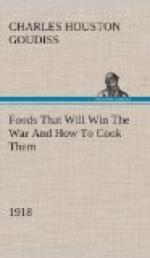It is claimed that the most serious food shortage in Germany is fat; that the civilian population is dying in large numbers because of the lack of it, and that Von Hindenburg’s men will lose out on the basis of fat, rather than on the basis of munitions or military organization. Worst of all is the effect of fat shortage on the children of the nation. Leaders of thought all over Europe assert that even if Germany wins, Germany has lost, because it has sapped the strength of its coming generation.
The term fat is used to designate all products of fatty composition and includes liquid fats such as oils, soft fats such as butter, and hard fats such as tallow. While all fats have practically the same energy-value, they differ widely from each other in their melting point, and the difference in digestibility seems to correspond to the difference in melting point. Butter burns at 240 degrees Fahrenheit, while vegetable oils can be heated as high as 600 degrees Fahrenheit, furnishing a very high temperature for cooking purposes before they begin to burn. The scorching of fat not only wastes the product, but renders it indigestible, even dangerous to some people, and for this reason butter should never be used for frying, as frying temperature is usually higher than 240 degrees. It is well to choose for cooking only those fats which have the highest heat-resisting qualities because they do not burn so easily.
Beginning with the lowest burning point, fats include genuine butter, substitute butters, lard and its substitutes, and end with tallow and vegetable oils. Of the latter, there is a varied selection from the expensive olive oil to the cheaper cottonseed, peanut, cocoanut and corn oils and their compounds and the hydrogenated oils.
The economy of fat, therefore, depends on the choice of the fat used for the various cooking processes as well as the conservation of all fatty residue, such as crackling, leftover frying fats and soup fat. For cooking processes, such as sauteing (pan frying), or deep fat frying, it is best to use the vegetable and nut oils. These are more plentiful, and hence cheaper than the animal fats; the latter, however, can be produced in the home from the fats of meats and leftover pan fats, which should not be overlooked as frying mediums. Butter and butter substitutes are best kept for table use and for flavoring. The hydrogenated oils, home-rendered fats, lard and beef and mutton suet can be used for shortening fats.
In the purchase of meats, the careful housewife should see that the butcher gives her all the fat she pays for, as all fats can be rendered very easily at home and can be used for cooking purposes. Butchers usually leave as large a proportion of fat as possible on all cuts of meat which, when paid for at meat prices, are quite an expensive item. All good clear fat should, therefore, be carefully trimmed from meats before cooking. Few people either like or find digestible greasy, fat meats, and the fat paid for at meat prices, which could have been rendered and used for cooking, is wasted when sent to table.




